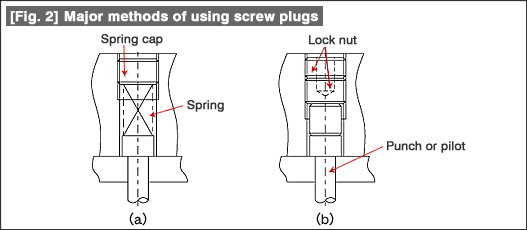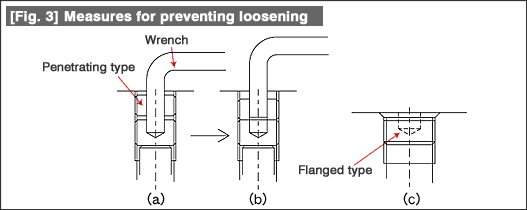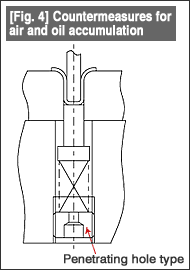#057 Method of Using Standard Components (6) Screws Plug
Screw plugs have been unified to have coarse thread pitch for sizes of M8 or less and a pitch of 1.5mm for M10 or more. This is for the purpose of making it easy to understand the relationship between the screw diameter and the spring when the screw plug is used as a cap screw for a spring, and also because, when the screw pitch becomes large in proportion to the screw diameter, it is also necessary to make the thickness of the screw plug larger in proportion to the screw diameter. If the screw pitch is the same, it is possible to make the thickness uniform. The screw plug standard has been prepared from this point of view.
There are five types of screw plugs used in dies as shown in Fig. 1. A screw plug is operated using a hexagonal bar spanner (referred to simply as 'spanner' in the following).

The basic shape is the one shown in (a) in which the spanner hole is not penetrating. The shape (b) has a penetrating spanner hole. The shape (c) is the basic shape with a penetrating round hole provided at the end of the spanner hole.
The shapes (d) and (e) are with a flange, and the two are different in the type of spanner hole.
The method of using a screw plug is shown in Fig. 2.

The method of use as a cap screw of a spring is shown in (a). This is the method of use when it is desired to adjust the strength of the spring by the extent of tightening the screw plug.
Care should be taken while using this method to make sure that the spring is compressed at all times. If the spring is not compressed, it shakes inside the hole, and consequently there is the danger that the screw plug becomes loose.
The method of use as a lock nut is shown in (b). A lock nut is a method of using the opposing forces of two screws to prevent the screws from becoming loose. The method of use is shown Fig. 3(a) and (b). An ordinary screw plug and one with a penetrating spanner hole are combined together.

To lock a lock nut, first the spanner is inserted and operated as shown in Fig. 3(a) until the nuts are tightened. After that, the spanner is lifted up as shown in Fig. 3(b) and only the screw plug with a penetrating spanner hole is tightened thereby preventing them from becoming loose. The screw plug with a penetrating spanner hole was developed for use as a lock nut.
Another method of preventing loosening is the flanged type screw plug. Elastic deformation occurs when the flange surface is strongly pressed against the hole. This is a type of screw plug in which loosening is prevented using this force.
| Figure 4 shows a shape that occurs frequently in dies. This figure shows and example of a step in a drawing operation. Drawing oil is used in a drawing operation. The drawing oil enters the hole of the spring by passing through the gap of the die. If it does not have an escape path, it gets collected at the bottom leasing to accidents (the accumulated oil cannot be seen from outside). As a countermeasure for this, there is the method of using a screw plug for a lock nut, and the method of using the penetrating hole type shown in Fig. 1(c). Fig. 1(c) is the type prepared for the purpose of removing air or oil. |  |
- #167 Problems in Punching and their Countermeasures (6) Scrap Processing in Punching
- #166 Problems in Punching and their Countermeasures (5) Trimming of Drawn and Shaped Parts
- #165 Problems in Punching and their Countermeasures (4) Scrap Clogging in Punching
- #164 Problems in Punching and their Countermeasures (3) Bending and Twisting of Narrow Punched Parts
- #163 Problems in Punching and their Countermeasures (2) Bending due to Punching



